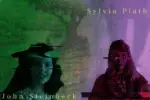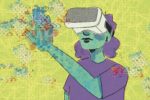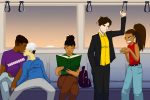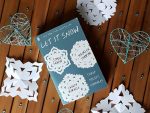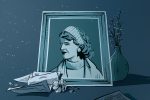Like many kids my age, I spent most of my formative years huddled in a corner with a book on my lap. In elementary school, I pored over “The Heroes of Olympus” series and became transfixed by Greek mythology. Later, my angst about private school phoniness and adult hypocrisy paraphrased Holden Caulfield’s rants from “The Catcher in the Rye.”
Yet, the books that shaped my worldview were overwhelmingly male-oriented. I read books with male protagonists and male perspectives, and apart from the creator of a certain boy wizard, these coming-of-age books were also chiefly male-authored. Some could argue that this gender imbalance was a natural effect of me gravitating toward authors and characters that felt relatable. Still, there existed a taboo surrounding female-authored books that permeated through my childhood. Gendered marketing and cultural misrepresentation relegated female-authored books to the dreaded “chick-lit” category: a frilly pink cloud where no boy would dare to explore.
So, while I am not prepared to totally disavow the books that made me me, here are a few recommendations of female-authored books for men interested in seeing a woman’s perspective to their coming-of-age favorites.
1. If you liked: “The Catcher in the Rye” by J.D. Salinger, read: “The Bell Jar” by Sylvia Plath
Many young teens can relate to the angst of the protagonist of “The Catcher in the Rye,” Holden Caulfield. He speaks to the bitterness of many teens torn between the innocence of their childhood and the corruption of their impending adulthood. Modern reviews of “Catcher” also emphasize how Holden’s conveyed angst may be emblematic of larger mental health issues, namely depression. Still, high school English teachers are mistaken to label “Catcher” as a universal teen novel: Salinger’s writing is definitively angry, and at times, even misogynistic.
To complement Catcher, Sylvia Plath’s “The Bell Jar” provides a more feminine perspective to a teen’s downward spiral. Plath crafts the partially autobiographical character of Esther Greenwood, a career-oriented young woman who battles depression. Unlike Holden, whose grief occurs before the novel’s opening chapter and permeates through the whole story, Esther gradually slips into her depression as the novel progresses, giving her story the character development that Holden’s lacks.
2. If you liked: “Looking For Alaska” by John Green, read: “Eleanor and Park” by Rainbow Rowell
John Green’s debut novel, “Looking For Alaska,” is equally iconic and problematic. Miles Halter falls in love with Alaska Young while attending a boarding school in Alabama; coming-of-age moments, hijinks and a life-changing tragedy ensue. Alaska is the embodiment of a flat female love interest: she is impossibly attractive, irresistibly quirky and exists to fill some niche in the quiet male protagonist’s life. While Green’s writing is erudite and can carry great meaning, Alaska comes across more like some manic pixie girl than a plausible female character.
In contrast, Rainbow Rowell’s “Eleanor and Park” provides a heterosexual teen romance in which both members of the couple are full, fleshed-out characters. Eleanor is poor and not conventionally attractive. Park is feminine and an avid comic book reader. The two fall in love while escaping bullies over successive bus rides to and from high school.
Like “Looking For Alaska,” Rowell taps into some dark places when crafting her love story; the novel’s main conflict stems from Eleanor’s abusive father, Richie. Rowell might not provide as many tattoo-worthy quotations as Green, but she crafts a love story in which both characters feel human, which is no small feat.
3. If you liked: “More Happy Than Not” by Adam Silvera, read: “Fun Home” by Alison Bechdel
“More Happy Than Not” is a modern classic about same-sex love and self-acceptance. The story follows Aaron Soto, a Latino Bronx teenager readjusting to life after his father’s suicide. Aaron befriends a new kid, Thomas, over one summer, and he soon develops confusing feelings for his new friend. Meanwhile, mentions of a new memory-erasing procedure hint that Aaron will do whatever he takes to suppress his homosexual thoughts, although the past is more difficult to escape than Aaron believes.
Alison Bechdel’s graphic memoir, “Fun Home,” is “More Happy Than Not”’s brainier, cooler cousin. Both novels deal with the themes of family secrets and the inescapability of memory. Both also feature LGBT+ characters at the forefront, and both tackle topics such as repressed sexuality and suicide with candor. Bechdel’s story expands on Silvera’s novel due to its truthfulness; where “More Happy” is science fiction, Bechdel’s bildungsroman is a vivid and intimate portrait of her own childhood.
4. If you liked: “The Spectacular Now” by Tim Tharp, read: “The Hate U Give” by Angie Thomas
“The Spectacular Now” takes the archetype of the charming party boy and then deconstructs how his hedonism may be ruining his life. Sutter Keely is an alcoholic high school senior with no plans after graduation. He falls in love with Aimee, a studious and agreeable girl, and comes to terms with how living exclusively in the “now” might be harming his life in the long term. Their love story is tender and sad, and Tharp does not sugarcoat how addiction causes Sutter to self-sabotage.
If “The Spectacular Now” is a story of privilege run amok, Angie Thomas’ “The Hate U Give” tells the more sobering perspective of the deeply unprivileged. The tour de force novel examines the effects of systemic racism in America. Thomas uses a young black teenage girl’s perspective to examine police brutality and a deeply corrupt justice system, exploring beyond the realm of fiction. It is difficult to return to Sutter Keely’s smarm after reading Starr Carter’s heart-wrenching and frighteningly realistic story of black American identity.
5. If you liked: “The Curious Incident of the Dog in the Night-Time” by Mark Haddon, read: “The Agony of Bun O’Keefe” by Heather T. Smith
Mark Haddon’s “The Curious Incident of the Dog in the Night-Time” tells the story of Christopher Dunne, an autistic 15-year-old boy who becomes entangled in a mystery after the death of his neighbor’s dog. Christopher’s first-person narration illuminates the inner mind of an autistic teenager, and the novel’s irreverent humor and clever use of detective story tropes make it a compelling read.
Heather T. Smith’s “The Agony of Bun O’Keefe” provides a more light-hearted romp to Haddon’s mystery novel, but it carries equal emotional weight. The novel is set in 1980s Newfoundland, and it follows Bun O’Keefe, an eccentric 14-year-old girl who leaves her hoarder mother and joins a home of misfits and outcasts in St. Johns.
Bun’s quirks might be more attributable to her sheltered upbringing than autistic disorder, but Smith’s novel deals with relative themes: alienation and morally ambiguous parenting. Plus, Bun’s naivety gives her a guileless outlook on life that provides a light tone akin to Chris’ inappropriate humor, even when both books address tough topics.
6. If you liked: “Ready Player One” by Ernest Cline, read: “Fangirl” by Rainbow Rowell
“Ready Player One” is an unabashed nerd fantasy. Cline examines a future in which half the world lives in a virtually reality game called OASIS. The story is an exciting chosen-one narrative, except the catch is that the key to amassing great fortune is memorizing obscure 1980s pop culture trivia. While all that sounds like harmless fun — and for the most part, it is — the book has come under fire in recent years for validating an exclusionary, sexist and outright dangerous gamer culture.
Fangirl is the perfect companion piece to “Ready” because it examines similar themes — escapism, being an outcast, and using pop culture as a defense mechanism — but Rowell sets the story on a much more personal scale. She tells the story of a young girl adjusting to college life while using her past identity as a fan fiction author to avoid coping with the myriad changes in her life.
By example, “Fangirl” provides female characters that are nuanced and well-rounded. Instead of celebrating reclusiveness, Rowell explicitly critiques the dangers of burying yourself in a fictional world and forgetting to explore real life.
In conclusion …
This is a list of some female-authored coming-of-age books I enjoyed, and it is by no means comprehensive. A well-rounded reader should appreciate stories from men, wome, and gender non-binary authors. They should also be able to recognize when sexist tropes occur in male-authored books without needing a female-authored companion.
There is no denying that female authors are capable of tapping into emotional nuances and points of view that male authors cannot. I hope more male readers continue to recognize the importance of reading female authors in forming more holistic perspectives on adolescence and coming-of-age.
Female-authored books do not just make us more adroit readers. Embracing diverse perspectives makes us better men.




